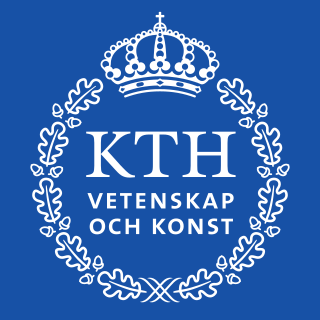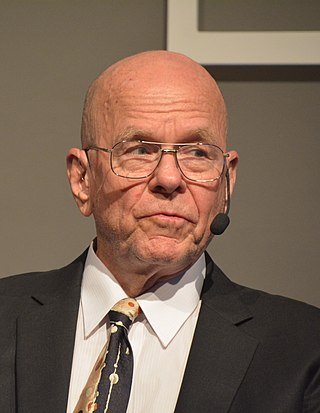Related Research Articles

Cellulose is an organic compound with the formula (C
6H
10O
5)
n, a polysaccharide consisting of a linear chain of several hundred to many thousands of β(1→4) linked D-glucose units. Cellulose is an important structural component of the primary cell wall of green plants, many forms of algae and the oomycetes. Some species of bacteria secrete it to form biofilms. Cellulose is the most abundant organic polymer on Earth. The cellulose content of cotton fibre is 90%, that of wood is 40–50%, and that of dried hemp is approximately 57%.

The KTH Royal Institute of Technology, abbreviated KTH, is a public research university in Stockholm, Sweden. KTH conducts research and education in engineering and technology and is Sweden's largest technical university. Currently, KTH consists of five schools with four campuses in and around Stockholm.

Lignin is a class of complex organic polymers that form key structural materials in the support tissues of most plants. Lignins are particularly important in the formation of cell walls, especially in wood and bark, because they lend rigidity and do not rot easily. Chemically, lignins are polymers made by cross-linking phenolic precursors.

Pulp is a fibrous lignocellulosic material prepared by chemically, semi-chemically or mechanically producing cellulosic fibers from wood, fiber crops, waste paper, or rags. Mixed with water and other chemicals or plant-based additives, pulp is the major raw material used in papermaking and the industrial production of other paper products.

Karl Barry Sharpless is an American stereochemist. He is a two-time Nobel laureate in Chemistry known for his work on stereoselective reactions and click chemistry.

Anthraquinone, also called anthracenedione or dioxoanthracene, is an aromatic organic compound with formula C
14H
8O
2. Several isomers exist but these terms usually refer to 9,10-anthraquinone wherein the keto groups are located on the central ring. It is used as a digester additive to wood pulp for papermaking. Many anthraquinone derivatives are generated by organisms or synthesised industrially for use as dyes, pharmaceuticals, and catalysts. Anthraquinone is a yellow, highly crystalline solid, poorly soluble in water but soluble in hot organic solvents. It is almost completely insoluble in ethanol near room temperature but 2.25 g will dissolve in 100 g of boiling ethanol. It is found in nature as the rare mineral hoelite.

The kraft process (also known as kraft pulping or sulfate process) is a process for conversion of wood into wood pulp, which consists of almost pure cellulose fibres, the main component of paper. The kraft process involves treatment of wood chips with a hot mixture of water, sodium hydroxide (NaOH), and sodium sulfide (Na2S), known as white liquor, that breaks the bonds that link lignin, hemicellulose, and cellulose. The technology entails several steps, both mechanical and chemical. It is the dominant method for producing paper. In some situations, the process has been controversial because kraft plants can release odorous products and in some situations produce substantial liquid wastes.

In industrial chemistry, black liquor is the by-product from the kraft process when digesting pulpwood into paper pulp removing lignin, hemicelluloses and other extractives from the wood to free the cellulose fibers.
The Anselme Payen Award is an annual prize named in honor of Anselme Payen, the French scientist who discovered cellulose, and was a pioneer in the chemistry of both cellulose and lignin.
Bleaching of wood pulp is the chemical processing of wood pulp to lighten its color and whiten the pulp. The primary product of wood pulp is paper, for which whiteness is an important characteristic. These processes and chemistry are also applicable to the bleaching of non-wood pulps, such as those made from bamboo or kenaf.

Spalting is any form of wood coloration caused by fungi. Although primarily found in dead trees, spalting can also occur in living trees under stress. Although spalting can cause weight loss and strength loss in the wood, the unique coloration and patterns of spalted wood are sought by woodworkers.
Peter Stilbs is an emeritus professor in physical chemistry at the Royal Institute of Technology (KTH) in Stockholm, Sweden.
Wood-free paper is paper created exclusively from chemical pulp rather than mechanical pulp. Chemical pulp is normally made from pulpwood, but is not considered wood as most of the lignin is removed and separated from the cellulose fibers during processing, whereas mechanical pulp retains most of its wood components and can therefore still be described as wood. Wood-free paper is not as susceptible to yellowing as paper containing mechanical pulp. Wood-free paper offers several environmental and economic benefits, including reduced deforestation, decreased energy consumption, and improved waste management. The term Wood-free paper can be rather misleading or confusing for someone unfamiliar with the papermaking process because paper is normally made from wood pulp derived from trees and shrubs.
In industrial paper-making processes, organosolv is a pulping technique that uses an organic solvent to solubilise lignin and hemicellulose. It has been considered in the context of both pulp and paper manufacture and biorefining for subsequent conversion of cellulose to fuel ethanol. The process was invented by Theodor Kleinert in 1968 as an environmentally benign alternative to kraft pulping.

Wood science is the scientific field which predominantly studies and investigates elements associated with the formation, the physical and chemical composition, and the macro- and microstructure of wood as a bio-based and lignocellulosic material. Wood science additionally delves into the biological, chemical, physical, and mechanical properties and characteristics of wood as a natural material.
Christina Moberg is a Swedish chemist who is a professor of Organic Chemistry at the KTH Royal Institute of Technology. She was elected an Honorary Fellow of the Royal Society of Chemistry in 2017.

The International Academy of Wood Science (IAWS) is an international academy and a non-profit assembly of wood scientists, recognizing all fields of wood science with their associated technological domains and securing a worldwide representation.
John Ralph is a New Zealand-born, American chemist, wood scientist, and professor at the University of Wisconsin-Madison. He is an elected fellow (FIAWS) of the International Academy of Wood Science and the American Association for the Advancement of Science (FAAAS).
Thomas Rosenau is a German-Austrian chemist and wood scientist specializing in chemistry, who is professor at the Department of Chemistry at BOKU University in Vienna, and also, elected member at the International Academy of Wood Science and honorary recipient of the Anselme Payen Award.
Kyösti Vilho Sarkanen (1921–1990) was a Finnish-American organic chemist and wood scientist, who served as a Professor at the University of Washington in Seattle. He was the honorary recipient of the Anselme Payen Award in 1979 from the American Chemical Society, and an elected fellow of the International Academy of Wood Science.
References
- ↑ "KTH Royal Institute of Technology, Stockholm (KTH) and other places". ResearchGate. Retrieved 2024-05-10.
- ↑ https://www.degruyter.com/document/doi/10.1515/hf-2021-0155/html Several other researchers have further elucidated the structure and reactions of lignin by 13C-NMR and other more advanced NMR techniques such as Charles H. Ludwig at Georgia Pacific Corporation Bellingham, Washington (USA), Josef Gierer at the Swedish Pulp and Paper Research Institute - STFI (Sweden), Larry Landucci at the USDA Forest Products Laboratory (USA), Josef Gratzl and Dimitris Argyropoulos at North Carolina State University (USA), Knut Lundquist at Chalmers University of Technology (Sweden) and John Ralph at the University of Wisconsin (USA)
- ↑ "Fellows". The International Academy of Wood Science. 2012-11-14. Retrieved 2024-05-10.
- ↑ "The Anselme Payen Award". Cellulose and Renewable Materials. 2024-04-03. Retrieved 2024-05-10.
- ↑ Gierer, J. (1980). "Chemical aspects of kraft pulping". Wood Science and Technology. 14 (4): 241–266. doi:10.1007/BF00383453. ISSN 0043-7719.
- ↑ Gierer, J. (1985). "Chemistry of delignification: Part 1: General concept and reactions during pulping". Wood Science and Technology. 19 (4): 289–312. doi:10.1007/BF00350807. ISSN 0043-7719.
- ↑ "Josef Gierer". Google Scholar. Retrieved 2024-05-10.